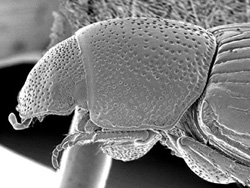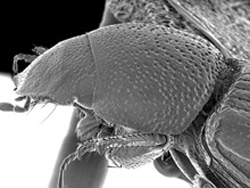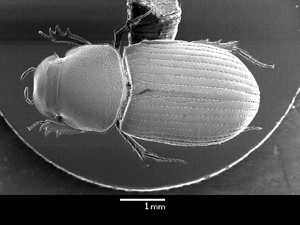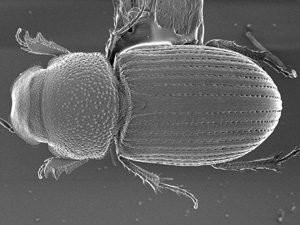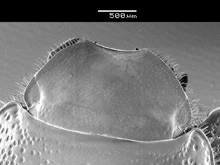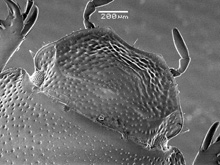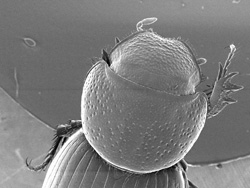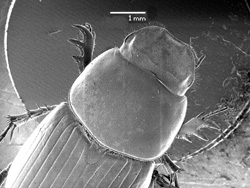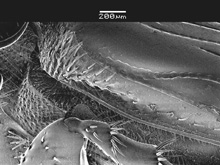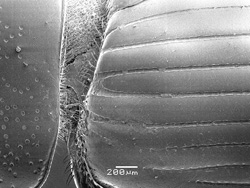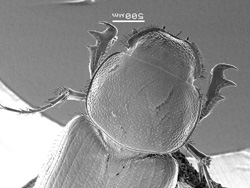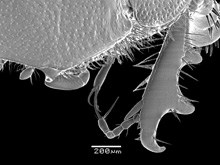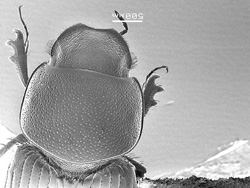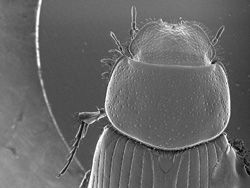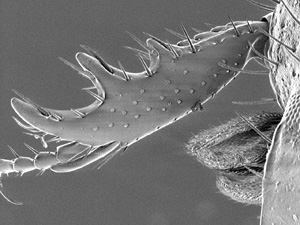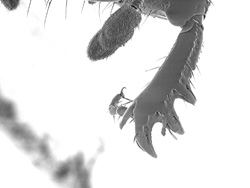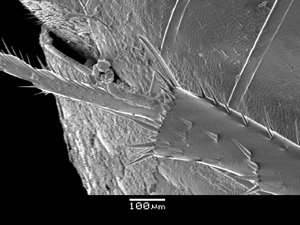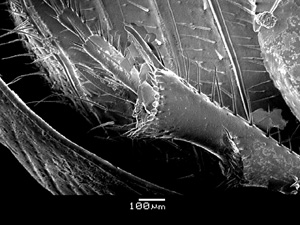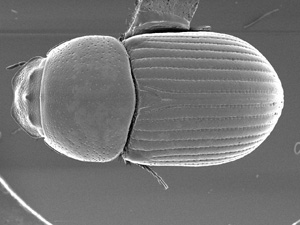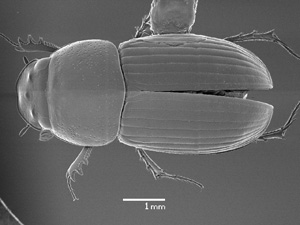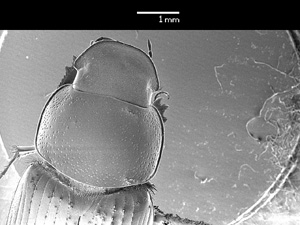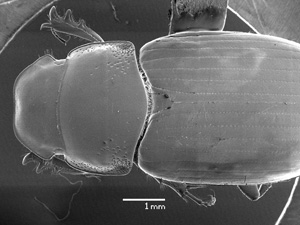|
|
| |
21(20).
.
.
|
Clypeal surface with long, erect setae (Fig. 35). Clypeal apex with nearly spiniform tooth on each side of middle. Southwestern North America |
Luxolinus
Gordon and
Skelley |
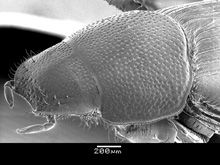 Figure35. Luxolinus luxatus
Figure35. Luxolinus luxatus
|
21'.
.
.
|
Clypeal surface without setae. Clypeal apex not toothed, possibly angulate (tooth short, broadly triangular) |
|
|
| |
|
| |
22(21).
.
.
|
Dorsal surface strongly dulled, with sculpture composed of very fine, polygonal meshes (Fig. 36). Elytral intervals flat. Northwestern North America |
Caligodorus
Gordon and Skelley (in part) |
| |
22'.
.
|
Dorsal surface shiny, if dull, then elytral intervals distinctly convex (Fig. 37) |
|
|
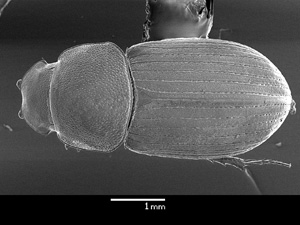 |
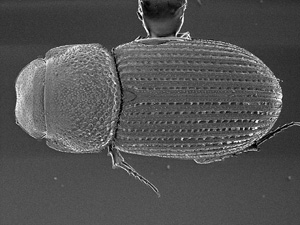 |
Figure 36. Caligodorus opacus. |
Figure 37. Dialyoidius decipiens. |
|
| |
|
| |
23(22).
.
.
|
Elytral interval 10 raised on posterior half, becoming the lateral margin (Fig. 38). All intervals complete to apical margin. Appalachian region of North America |
.
Hornietus
Stebnicka |
| |
23'.
.
.
|
Elytral interval 10 not notably raised, not forming lateral margin (Fig. 39). Some intervals fused before attaining margin |
|
|
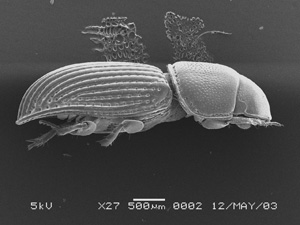 |
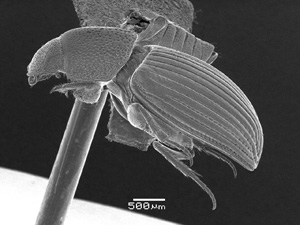 |
Figure 38. Hornietus ventralis. |
Figure 39. Dialytellus dialytoides. |
|
| |
|
| |
24(23).
.
|
Posterior pronotal angles laterally emarginate (Fig. 40). Eastern North America |
Dialytellus
Brown |
| |
24'.
.
.
|
Posterior angles not emarginate, base of pronotum rectangular (Fig. 41). North Dakota and Nevada to British Columbia and California |
|
|
|
|
Figure 40. Dialytellus dialytoides. |
Figure 41. Dialytodius carr. |
|
| |
|
| |
25(24).
.
.
.
|
Elytral color yellow or yellowish brown. Elytral intervals weakly convex, nearly flat (Fig. 42). Elytra narrow basally, distinctly widened on apical declivity. California |
Caligodorus Gordon and
Skelley
(in part) |
| |
25'.
.
.
.
|
Elytral color brown or black. Elytral intervals distinctly convex to tectiform (Fig. 43). Elytra widest at middle or slightly wider on apical declivity. Northwestern North America |
|
|
|
|
Figure 42. Calidodorus vandyke. |
Figure 43. Dialytodius carr. |
|
| |
|
| |
26(7).
.
.
.
.
|
Clypeus with distinct, long, dense lateral fringe of setae, visible dorsally (Fig. 44). Clypeus angulate or toothed, if clypeus rounded, then pronotum and elytron also with dense, long setal fringe. Head lacking median frontal tubercle |
..
.
.
27 |
| |
26'.
.
.
.
|
Clypeus at most with sparse fringe of setae, frontal lobe often fringed (Fig. 45). If clypeus angulate or toothed, then setal fringe lacking. Head with or without frontal tubercle |
|
|
|
|
Figure 44. Dellacasiellus carpinterius. |
Figure 43. Pardalosus sayi. |
|
| |
|
| |
27(26).
.
|
Pronotum distinctly narrowed to base, posterior angles absent (Fig. 46) |
Stenotothorax Schmidt (in part) |
| |
27'.
.
.
.
.
|
Pronotum not narrowed toward base, or with posterior angles present, often weakly indicated (Fig. 47); if posterior angles weak, then apical tooth of protibia larger than medial tooth and projecting at right angle to axis of tibia (Cinacanthus) |
|
|
|
|
Figure 46. Stenotothorax nevadensis. |
Figure 47. Dellacasiellus laevigatus. |
|
| |
|
| |
28(27).
.
.
.
|
Head nearly semicircular (Fig. 48). Clypeus lacking teeth and median emargination. Southwestern North America
. |
Cephalocyclus Dellacasa, Gordon and Dellacasa (in part) |
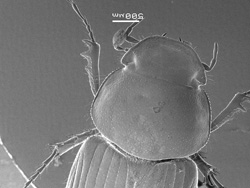
Figure 48. Cephalocyclus hogei. |
28'.
.
|
Head not semicircular. Clypeus with teeth or distinct median emargination |
|
|
| |
|
| |
29(28).
.
.
.
.
.
|
Body robust, reddish. Elytral fold with deep setose groove at base (Fig. 49), lacking only in D. laevigatus from southeastern US. Base of elytral striae 3‑5 usually widened and sharply margined, interval 4 usually narrowed at base (Fig. 50). Clypeal apex denticulate or angulate. North America and Mexico |
.
.
.
.
Dellacasiellus
Gordon and Skelley |
| |
29'.
.
.
.
|
Body color and shape variable. Elytral fold lacking deep setose groove at base. Base of elytral striae 3‑5 not widened, interval 4 not narrowed at base. Clypeus variable, often distinctly toothed |
|
|
|
|
Figure 49. Dellacasiellus concavus. |
Figure 50. Dellacasiellus concavus. |
|
| |
|
| |
30(29).
.
.
|
Pronotal base S‑shaped with angulation each side of middle (Fig. 51), with or without marginal line at base. Southwestern North America, Mexico |
.
Coelotrachelus Schmidt |
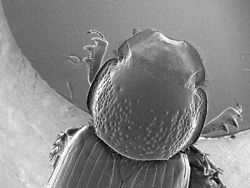 Figure 51. Coelotrachelus rudis.
Figure 51. Coelotrachelus rudis. |
30'.
.
|
Pronotal base weakly sinuate, lacking angulation, with complete marginal line at base |
|
|
| |
|
| |
31(30).
.
.
..
.
.
.
.
|
Clypeal teeth spiniform. Protibia with apical tooth large and projecting at right angle to axis of tibia (Fig. 52). Protibial spur inserted opposite second protibial tooth (Fig. 53). Male protibial spur extremely reduced in size, concealed beneath tibial border; female protibial spur small, visible in dorsal view. Body uniformly red. Great Plains and western North America |
.
.
.
.
.
.
Cinacanthus
Schmidt |
| |
31'.
.
.
.
.
|
Clypeal teeth at most strongly angulate, rarely appearing spiniform. Protibia with apical tooth not enlarged, projecting more anteriorly. Protibial spurs large, variably set, usually inserted closer to apical tooth, visible dorsally in both sexes. Body color variable |
|
|
|
|
Figure 52. Cinacanthus militaris. |
Figure 53. Cinacanthus militaris. |
|
| |
|
| |
32(31).
.
.
|
Small, length nearly 3 mm. Elytron yellowish with distinct black markings. California and Mexico
. |
Rugaphodius
Gordon and Skelley (in part) |
| |
32'.
.
|
Larger, length greater than 5 mm. Elytron variable, lacking distinct black markings. Widespread |
|
|
| |
|
| |
33(32).
.
.
.
.
.
.
|
Body black dorsally. Clypeus with two broadly placed, angulate teeth (Fig. 54), lacking modified margin between teeth. Epipharynx with corypha short, with cluster of 4‑6 apical spines. Head lacking distinct lateral notch at frontal suture. Pronotum and elytra lacking distinct lateral fringe of long setae. North America and Mexico |
.
.
.
Pseudagolius
Schmidt (in part) |
| |
33'..
.
.
.
.
.
.
.
. |
Body black, reddish brown, or pale dorsally. Clypeus with 4, 2 or no teeth, teeth often narrowly spaced (Fig. 55); when present clypeal teeth varying from nearly spiniform to broadly angulate, some with margin between teeth triangularly modified. Epipharynx with corypha strongly projecting, peg‑like, with 2 stout apical spines. Head on some with distinct notch laterally at frontal suture. Pronotum and elytra on some with distinct lateral fringe of long setae. Western North America |
|
|
|
|
Figure 54. Pseudagolius bicolor. |
Figure 55. Tetraclipeoides dentigerulus. |
|
| |
|
| |
34(26).
.
|
Pronotum distinctly narrowed from apex to base (Fig. 56), posterior angles absent. North America |
Stenotothorax Schmidt (in part) |
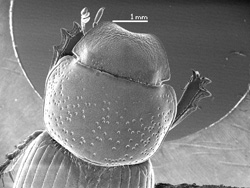 Figure 56. Stenothorax lanei.
Figure 56. Stenothorax lanei. |
34'.
.
|
Pronotum not narrowed toward base, or with posterior angles present; or from elsewhere. Widespread |
|
|
| |
| |
| |
35(34).
.
.
|
Dorsal surface of protibia distinctly, densely punctured (Fig. 57). Clypeal apex lacking teeth, rounded on each side of middle |
.
.
36 |
| |
35'.
.
|
Dorsal surface of protibia impunctate (Fig. 58). Clypeal apex with teeth or not |
|
|
|
|
Figure 57. Blackburneus fordi. |
Figure 58. Oscarinus lodingi. |
|
| |
|
| |
36(35).
.
|
Alternate elytral intervals distinctly carinate, other intervals flat. Panama to northern South America |
Xenoheptaulacus Hinton |
| |
36'.
.
|
Elytral intervals all equally convex, none carinate. Widespread |
|
|
| |
|
| |
37(36).
.
.
.
|
Apical tibial fringe of setae long and unequal in length (Fig. 59). Elytra variably setose laterally and dorsally; glabrous, with setal patch near lateral apex, or entirely setose. Head never with median tubercle |
.
.
.
38 |
| |
37'.
.
.
|
Apical tibial fringe of setae short and equal in length (Fig. 60). Elytra never setose. Head of males with distinct median tubercle, female tubercle weak |
|
|
|
|
Figure 59. Blackburneus sterocorosus. |
Figure 60. Haroldiellus sallei. |
|
| |
|
| |
38(37).
.
.
|
Elytra variably setose, setae often limited to lateral apex. If elytra dorsally setose, then from North America. Widespread |
.
Blackburneus Schmidt |
| |
38'.
.
|
Elytral surface entirely setose. Brazil (?)
. |
|
|
| |
|
| |
39(37).
.
.
.
|
Elytral striae coarsely punctured, intervals strongly convex. Pronotal base with fine marginal line (Fig. 61). Body robust, dark reddish brown. Caribbean and Central America to southern Texas |
Haroldiellus
Gordon
and Skelley
(in part) |
| |
39'.
.
.
.
|
Elytral striae finely punctured, intervals weakly convex. Pronotal base lacking marginal line (Fig. 62). Body weakly robust, brown, with weak pattern on apex of elytra. South America |
|
|
|
|
Figure 61. Haroldiellus sallei. |
Figure 62. Trichaphodiellus brasiliensis. |
|
| |
|
| |
40(35).
.
.
.
|
Clypeal apex broadly semicircular (Fig. 63). Frontal lobe pronounced, triangular, projecting far beyond eye. Head black. Lateral pronotal margin with wide, distinctly raised border. Eastern North America |
.
.
Acrossus
Mulsant |
| |
40'.
.
.
.
.
.
|
Clypeal apex usually emarginate medially (Fig. 64); if semicircular, then narrowed, or head pale, not black, or frontal lobe not pronounced. If frontal lobe triangular, then not projecting much beyond eye. Lateral pronotal margin, if present, narrow, slightly raised. Widespread |
|
|
|
|
Figure 63. Acrossus rubripennis. |
Figure 64. Cryptoscatomaseter haldemani.
|
|
| |






